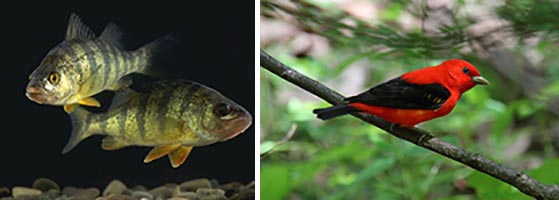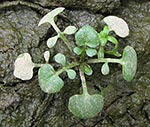 Allens Fresh, Charles County
Allens Fresh, Charles County
The expansive marshes of Allens Fresh lure paddlers upstream in pursuit of a
bald eagle or osprey soaring overhead, a heron stalking the shoreline for
prey, or perhaps the rise of a yellow perch or a glimpse of a northern river
otter sliding down a marsh bank. Visitors witness the diminishing influence
of tide and salinity as they proceed upstream. Brackish tidal marshes of
cordgrass transition to fresh tidal marshes of wild rice, rice cutgrass and
pickerelweed. The receding tide exposes sandy mudflats that provide habitat
for the globally rare Long's bittercress (Cardamine longii, State
listed as Endangered) and the rare wetland flower, spongy lophotocarpus (Sagittaria
calycina). Beyond the marshes, tidal shrublands and forests of willow
oak, green ash, and swamp rose yield to nontidal forests of cherrybark oak,
red maple, blackgum and sweetgum.
The marshes and swamp forests of Allens Fresh help to maintain the water
quality of the Potomac River and ultimately the Chesapeake Bay by absorbing
nutrients and chemicals and trapping sediments that run off from roads, farm
fields, and subdivisions. Even so, the sandy, tidal mudflats and rare plants
are threatened by excessive runoff. Allens Fresh comprises more than 250
acres owned by the State and managed by the Maryland Park Service.

 Rarity Refuge
Rarity Refuge
Long's bittercress is a small plant of the mustard family named after Bayard Long, a Pennsylvania botanist who discovered it in the early 1900s. Its flowers have no petals, but produce tiny versions of the slender capsules that are typical of this plant family. Fewer than 100 populations of this plant are known to exist worldwide, and Allens Fresh harbors one of only two populations on Maryland's Western Shore.
Triumphant Return

Bald eagles and ospreys are now abundant in Allens Fresh and along the
shoreline of Charles County, but this wasn’t always the case. The widespread
use of DDT and organochlorine pesticides in the mid-1900s led to a severe
decline in the numbers of bald eagles and ospreys in the United States.
These chemicals became concentrated through the food chain, absorbed by
aquatic plants and fish, the birds' preferred food, and caused the birds to
produce weak egg shells that broke in the nest or did not hatch. The bald
eagle was federally listed as Endangered in 1967.
With the ban on DDT in
1972, populations of eagles and ospreys began to recover. In 1995, the bald
eagle was federally downlisted to Threatened, and in 2007 it was delisted.
Maryland delisted the bald eagle from state regulation in 2010. Between 1997
and 2004, biologists documented a 10-fold population increase in bald eagles
in Maryland. By the late 1990s over 3,500 pairs of osprey were thriving in
the Chesapeake Bay watershed. Bald eagles and ospreys are now great examples
of conservation success stories. As our nation’s symbol, the bald eagle
continues to be protected under the U.S. Bald and Golden Eagle Protection
Act, and both the bald eagle and the osprey are protected under the
Migratory Bird Treaty Act.
 Click here for a Print Version of this map.
Click here for a Print Version of this map.
MD DNR Map of Allens Fresh Natural Area
Special Note: Allens Fresh Natural Area is used seasonally by hunters.
Directions
From Waldorf: Take US 301 (Crain Highway) south past
Waldorf to La Plata. Continue south about 9 miles to MD 234 (Budds
Creek Road). Turn left (east) and proceed about a mile to the
canoe/kayak access areas on the north side of the road on either
side of the Budds Creek Road bridge. Park in one of the access
areas; keep alert to oncoming traffic.


Driving directions and aerial views open with Google Maps. For the aerial view button, if an aerial view does not open by default, click on the Satellite icon in the upper right corner and Google Maps will switch to an aerial view of the Natural Area.

Acknowledgements:
Scenic view of Allens Fresh Natural Area, photo by Kerry Wixted
Photo Collage:
The slow-moving, tidal waters at Allens Fresh, combined with ample vegetation, provide food and shelter for yellow perch. Photo by: USDA/Wikimedia Commons.
Left: Look for the handsome scarlet tanager within the forest interior. Despite their bold coloring, the birds are often undetected due to their secretive nature. Photo by: Yukun Xing.
The rare Long's bittercress grows only in tidal estuaries. Pollution, erosion and invasive species are its greatest threats. Photo by: Kerry Wixted
Photo Collage:
Left: Bald eagles prefer to build their massive stick nests in large trees along rivers and coastlines where they have easy access to aquatic prey. Some nests have been known to weigh as much as a ton. Photo by: Wikimedia Commons.
Right: Ospreys feed almost exclusively on fish and will plunge up to three feet underwater to capture their slippery prey. They will readily use man-made platforms to construct their bulky stick nests. Photo by: NASA/Wikimedia Commons.